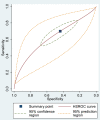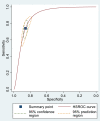History-taking, Clinical Signs, Tests and Scores for Detection of Non-organic Dyspepsia (NOD) Among Patients With Acute Abdominal Pain (AAP)
- PMID: 35403135
- PMCID: PMC8988958
- DOI: 10.21873/cdp.10034
History-taking, Clinical Signs, Tests and Scores for Detection of Non-organic Dyspepsia (NOD) Among Patients With Acute Abdominal Pain (AAP)
Abstract
Background/aim: The diagnostic accuracy of history-taking, clinical signs and tests and diagnostic scores (DSs) for patients with non-organic dyspepsia (NOD) have been rarely evaluated.
Patients and methods: A cohort of 1333 patients presenting with acute abdominal pain (AAP) were studied, including 50 patients with confirmed NOD. The most significant diagnostic variables (in multivariate logistic regression analysis) were used to construct six different DS models and their diagnostic accuracy was compared with clinical symptoms and signs and tests. Meta-analytical techniques were used to detect the summary sensitivity (Se) and specificity (Sp) estimates for each data set (symptoms, signs and tests as well as DS models).
Results: In hierarchical summary receiver operating characteristic (HSROC) analysis, the area under curve (AUC) values for i) symptoms ii) signs and tests iii) DS were as follows: i) AUC=0.608 [95% confidence interval (CI)=0.550-0.666]; ii) AUC=0.621 (95% CI=0.570-0.672) and iii) AUC=0.877 (95% CI=0.835-0.919). The differences between these AUC values (roccomp analysis) are as follows: between i) and ii) p=0.715; between i) and iii) p<0.0001; between ii) and iii) p<0.0001.
Conclusion: The present study is the first to provide evidence that the DS could be used in diagnosis of NOD. The major advantage of our DS is that this model does not need radiology or endoscopy to reach high diagnostic accuracy.
Keywords: HSROC; Non-organic dyspepsia; diagnostic accuracy; diagnostic score; signs; symptoms; tests.
Copyright 2021, International Institute of Anticancer Research.
Conflict of interest statement
The Authors report no conflicts of interest or financial ties.
Figures









Similar articles
-
A Diagnostic Score (DS) Is a Powerful Tool in Diagnosis of Acute Appendicitis in Elderly Patients With Acute Abdominal Pain.Anticancer Res. 2021 Mar;41(3):1459-1469. doi: 10.21873/anticanres.14904. Anticancer Res. 2021. PMID: 33788738
-
A Diagnostic Score for Acute Small Bowel Obstruction.Anticancer Res. 2021 Apr;41(4):1959-1970. doi: 10.21873/anticanres.14963. Anticancer Res. 2021. PMID: 33813402
-
A Simple Prediction Score for Diagnosis of Acute Pancreatitis.In Vivo. 2022 Sep-Oct;36(5):2287-2296. doi: 10.21873/invivo.12958. In Vivo. 2022. PMID: 36099125 Free PMC article.
-
Accuracy of Rapid Point-of-Care Diagnostic Tests for Hepatitis B Surface Antigen-A Systematic Review and Meta-analysis.J Clin Exp Hepatol. 2014 Sep;4(3):226-40. doi: 10.1016/j.jceh.2014.07.008. Epub 2014 Aug 28. J Clin Exp Hepatol. 2014. PMID: 25755565 Free PMC article. Review.
-
Diagnostic value of neutrophil gelatinase-associated lipocalin for early diagnosis of cardiac surgery-associated acute kidney injury: a meta-analysis.Eur J Cardiothorac Surg. 2016 Mar;49(3):746-55. doi: 10.1093/ejcts/ezv199. Epub 2015 Jun 20. Eur J Cardiothorac Surg. 2016. PMID: 26094017 Review.
Cited by
-
Accuracy of Prediction Models in Diagnosis of Acute Diverticulitis.In Vivo. 2023 Nov-Dec;37(6):2597-2608. doi: 10.21873/invivo.13367. In Vivo. 2023. PMID: 37905624 Free PMC article.
References
-
- Eskelinen M, Selander T, Lipponen P, Juvonen P. History-taking and the Usefulness Index in the diagnosis of functional dyspepsia. Isr Med Assoc J. 2014;16(8):497–501. - PubMed
LinkOut - more resources
Full Text Sources
Miscellaneous
